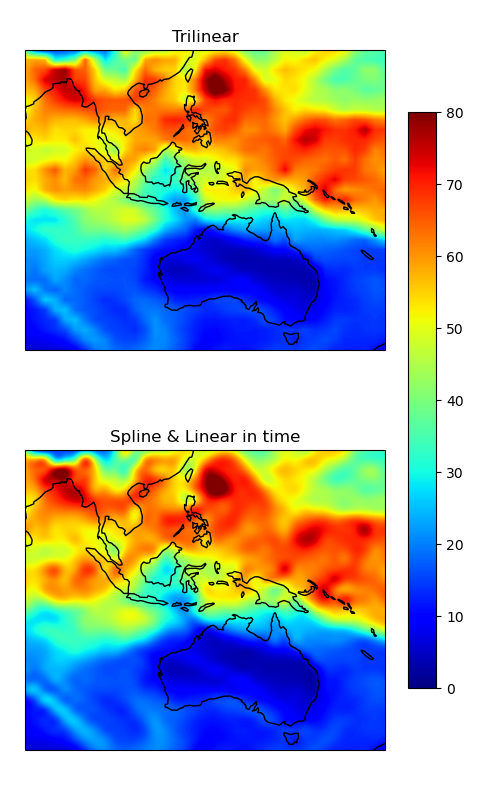Note
Go to the end to download the full example code. or to run this example in your browser via Binder
3D Interpolation#
This example demonstrates how to perform 3D interpolation on a regular grid. The pyinterp library supports both trivariate and bicubic interpolation for 3D data.
import cartopy.crs
import matplotlib
import matplotlib.pyplot
import numpy
import pyinterp
import pyinterp.backends.xarray
import pyinterp.tests
Trivariate Interpolation#
Trivariate interpolation extends bivariate interpolation to three dimensions. It performs a bilinear interpolation on the 2D spatial plane (longitude and latitude) and then a linear interpolation on the third dimension (in this case, time).
First, we load the 3D dataset and create the interpolator object.
Next, we define the coordinates for interpolation. To avoid interpolating at the exact grid points, we introduce a slight shift.
Note
When working with a time axis, ensure that the date units are consistent
between the grid and the interpolation coordinates. The
pyinterp.TemporalAxis.safe_cast() method can help manage date
conversions and prevent inconsistencies.
mx, my, mz = numpy.meshgrid(numpy.arange(-180, 180, 0.25) + 1 / 3.0,
numpy.arange(-80, 80, 0.25) + 1 / 3.0,
numpy.array(['2002-07-02T15:00:00'],
dtype='datetime64'),
indexing='ij')
Now, we perform the trivariate interpolation.
trivariate = interpolator.trivariate({
'longitude': mx.ravel(),
'latitude': my.ravel(),
'time': mz.ravel()
})
Bicubic Interpolation on a 3D Grid#
For smoother results, you can use bicubic interpolation for the spatial dimensions, followed by a linear interpolation on the third dimension.
Note
Bicubic interpolation requires that the grid axes are strictly increasing.
If your latitudes are in descending order, you can set the increasing_axes
parameter to True to automatically flip them.
interpolator = pyinterp.backends.xarray.Grid3D(ds.data_vars['tcw'],
increasing_axes=True)
We then perform the bicubic interpolation.
To visualize the results, we reshape the output arrays and extract the longitude and latitude coordinates.
trivariate = trivariate.reshape(mx.shape).squeeze(axis=2)
bicubic = bicubic.reshape(mx.shape).squeeze(axis=2)
lons = mx[:, 0].squeeze()
lats = my[0, :].squeeze()
Finally, let’s plot the results of both trivariate and bicubic interpolation.
fig = matplotlib.pyplot.figure(figsize=(10, 8))
fig.subplots_adjust(left=0.05, right=0.95, top=0.95, bottom=0.05, hspace=0.25)
ax1 = fig.add_subplot(
211, projection=cartopy.crs.PlateCarree(central_longitude=180))
ax1.set_extent([-180, 180, -90, 90], crs=cartopy.crs.PlateCarree())
pcm = ax1.pcolormesh(lons,
lats,
trivariate.T,
cmap='jet',
shading='auto',
transform=cartopy.crs.PlateCarree())
ax1.coastlines()
ax1.set_title('Trivariate Interpolation')
ax2 = fig.add_subplot(
212, projection=cartopy.crs.PlateCarree(central_longitude=180))
ax2.set_extent([-180, 180, -90, 90], crs=cartopy.crs.PlateCarree())
pcm = ax2.pcolormesh(lons,
lats,
bicubic.T,
cmap='jet',
shading='auto',
transform=cartopy.crs.PlateCarree())
ax2.coastlines()
ax2.set_title('Bicubic Interpolation')
fig.colorbar(pcm, ax=[ax1, ax2], shrink=0.8)

<matplotlib.colorbar.Colorbar object at 0x13be83320>
Same plot as above, but zoomed into a specific region to better highlight the differences between the two interpolation methods.
fig = matplotlib.pyplot.figure(figsize=(5, 8))
fig.subplots_adjust(left=0.05, right=0.95, top=0.95, bottom=0.05, hspace=0.25)
ax1 = fig.add_subplot(
211, projection=cartopy.crs.PlateCarree(central_longitude=180))
pcm = ax1.pcolormesh(lons,
lats,
trivariate.T,
cmap='jet',
shading='auto',
transform=cartopy.crs.PlateCarree(),
vmin=0,
vmax=80)
ax1.coastlines()
ax1.set_extent([80, 170, -45, 30], crs=cartopy.crs.PlateCarree())
ax1.set_title('Trilinear')
ax2 = fig.add_subplot(
212, projection=cartopy.crs.PlateCarree(central_longitude=180))
pcm = ax2.pcolormesh(lons,
lats,
bicubic.T,
cmap='jet',
shading='auto',
transform=cartopy.crs.PlateCarree(),
vmin=0,
vmax=80)
ax2.coastlines()
ax2.set_extent([80, 170, -45, 30], crs=cartopy.crs.PlateCarree())
ax2.set_title('Spline & Linear in time')
fig.colorbar(pcm, ax=[ax1, ax2], shrink=0.8)

<matplotlib.colorbar.Colorbar object at 0x13beee630>
Total running time of the script: (0 minutes 8.390 seconds)